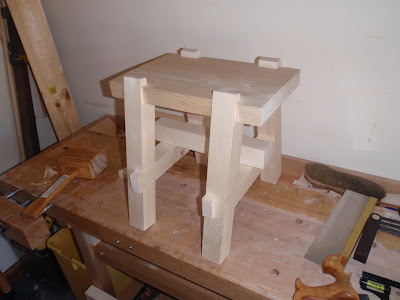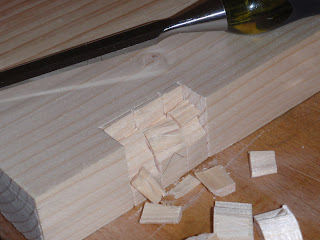First, the lap joint sockets need to be marked in the legs.
After marking out using the knife and being careful to get the complimentary 10 degree splay angle in the correct direction, I pared the cut lines with a chisel, before making three cuts per socket to help allow the waste to be easily removed with a chisel.
Two stools with four legs each, times three cuts per leg equals twenty four cuts to be made just for half a lap joint. What seems like an easy process seems to take me a lot longer than I think it will. It's easy to kill a few hours and not achieve an awful lot of progress...
Using the vice to hold the stock flush with my marking lines, I used the smaller chisel to remove most of one side of the socket to the center.
Then I flipped the work piece around to do the other side.
Then used the large chisel places directly in the baseline, using the vice jaws to keep the chisel face flat.
Finally finishing off by hand and paring away any roughness.
Now it was back to the bench hook to cut four lengths of wood, two braces per stool.
I placed the square braces directly into the sockets in the legs and marked out the joints to be cut with the seat top attached using a pencil. It was nice to see the pencil marks agreeing with both my square and bevel gauge almost exactly, meaning my joints must be acceptable and the stool is remaining pretty square.
It's actually starting to look a bit like a stool... The center brace (just sitting in place in the picture above) is nice and straight forward with the joints cut at a sensible 90 degrees and therefore there is no messing around with bevel gauges. A couple of minutes center finding using dividers, some squared lines with the knife and a few strokes of the saw and a bit of chisel work later ...
We have a stool! On my previous stool I cut the center brace flush with the side braces, but this time I thought I would try and make a 'feature' of the end grain of the center brace which in turn will result in a stronger joint. In fact, even without any glue I was able to sit on the stool - albeit very carefully!
So ... Now repeat all the above for the other stool. *Sigh* I kind of wish I had done one stool at a time now as the progress would have been a lot faster. It's surprising how much time it takes to build such a simple little project.
We have a stool! On my previous stool I cut the center brace flush with the side braces, but this time I thought I would try and make a 'feature' of the end grain of the center brace which in turn will result in a stronger joint. In fact, even without any glue I was able to sit on the stool - albeit very carefully!
So ... Now repeat all the above for the other stool. *Sigh* I kind of wish I had done one stool at a time now as the progress would have been a lot faster. It's surprising how much time it takes to build such a simple little project.
Still to do:
- Bevel and smooth all the edges and surfaces.
- Dry fit and final trimming of joinery, before glue up.
- Flush cut all the joints and trim the legs to match the splay angle so the 'feet' sit square.
- Sand and finish.





























